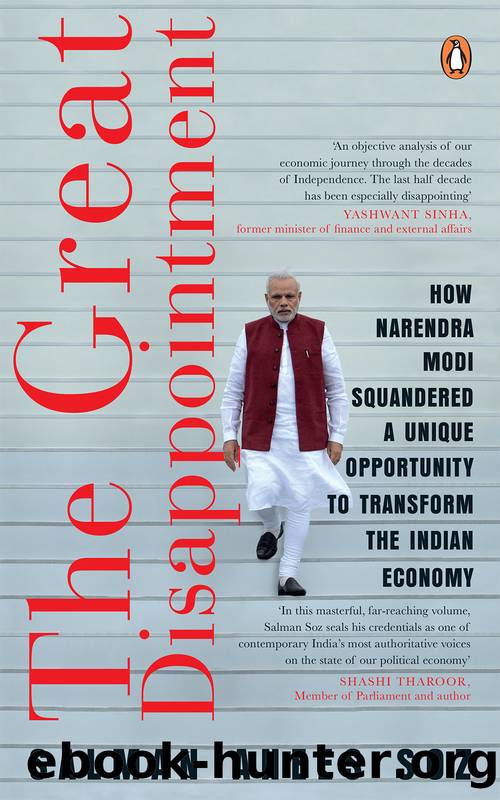The Great Disappointment by Salman Anees Soz

Author:Salman Anees Soz [Soz, Salman Anees]
Language: eng
Format: epub
ISBN: 9789353054885
Publisher: Penguin Random House India Private Limited
Published: 2019-03-07T00:00:00+00:00
International trade and current account
Over time, exports have become a big part of Indiaâs economic growth story. In 1990, exports were only 7 per cent of the GDP, whereas in China the ratio was 14 per cent. In 2013, Indiaâs exports reached a high of 25.4 per cent of the GDP (higher than Chinaâs 24.5 per cent). This ratio has come down to just under 19 per cent in 2017. Chinaâs ratio has dropped below 20 per cent.52 It is in this context that Indiaâs export performance has drawn serious attention in recent years.
Exports have shown weakness for much of PM Modiâs tenure, but this is a continuation of a trend that started in the last few years of the previous governmentâs tenure. This is partly a reflection of weakness in global demand for product categories in Indiaâs export basket (such as engineering goods, gems and jewellery, chemicals and ready-made garments).53 Even so, exports have grown by about 2.6 per cent over the last five years while they were growing at about 18 per cent in the five-year period from 2003â04 to 2007â08, when economic growth averaged about 8.5 per cent per annum. Clearly, global weaknesses have a role to play in this weak export performance.
External factors alone do not account for Indiaâs weak export performance. Domestic bottlenecks are also to blame. Initiatives such as demonetization and the rollout of the GST have contributed to the slowdown in exports. Agricultural exports have come down as well. Meanwhile, agricultural imports have gone up.54, 55, 56 Sajjid Chinoy, Chief India Economist for J.P. Morgan, has pointed out that without sustained and higher export growth rates or a significant rise in domestic consumption, Indiaâs economic growth is likely to remain well below potential.57
Exports have revived recently, with growth at 9.8 per cent in 2017â18. However, this figure hides a deeper worry. An analysis by Business Standard shows that Indian exports grew by an average 22 per cent during 2004â05 to 2008â09. This growth dropped to 12.3 per cent during 2009â10 to 2013â14. However, under the Modi government, exports shrank by an average -0.4 per cent in the first four years of its tenure. Given the prime ministerâs desire to make India into an export powerhouse and his support for Make in India, this weakness in exports was unexpected.
More importantly, it is Indiaâs openness to trade that is causing discomfort to both supporters and opponents of PM Modi. IMF data indicates that in 2016, âIndiaâs trade opennessâthe sum of exports and imports to GDPâwas 27 per centâ. This compares very unfavourably to the 43 per cent achieved in 2012.58 With the government adopting a policy framework that appears to be protectionist, India could be on a path eschewed a long time ago.
As mentioned elsewhere, Modi championed globalization in Davos at the WEF in early 2018 and warned against forces of protectionism. Shortly thereafter, India raised tariffs on a variety of products, including smartphones. This has led to much hand-wringing, including by Panagariya who has
Download
This site does not store any files on its server. We only index and link to content provided by other sites. Please contact the content providers to delete copyright contents if any and email us, we'll remove relevant links or contents immediately.
Zero to IPO: Over $1 Trillion of Actionable Advice from the World's Most Successful Entrepreneurs by Frederic Kerrest(4046)
Machine Learning at Scale with H2O by Gregory Keys | David Whiting(3613)
Harry Potter and the Goblet Of Fire by J.K. Rowling(3608)
Never by Ken Follett(3520)
Ogilvy on Advertising by David Ogilvy(3327)
Shadow of Night by Deborah Harkness(3173)
The Man Who Died Twice by Richard Osman(2805)
Book of Life by Deborah Harkness(2717)
My Brilliant Friend by Elena Ferrante(2698)
How Proust Can Change Your Life by Alain De Botton(2613)
0041152001443424520 .pdf by Unknown(2592)
Will by Will Smith(2577)
The Tipping Point by Malcolm Gladwell(2554)
How to Pay Zero Taxes, 2018 by Jeff A. Schnepper(2498)
Purple Hibiscus by Chimamanda Ngozi Adichie(2481)
Hooked: A Dark, Contemporary Romance (Never After Series) by Emily McIntire(2416)
Rationality by Steven Pinker(2148)
Borders by unknow(2116)
Daughter of Smoke and Bone by Laini Taylor(2077)
